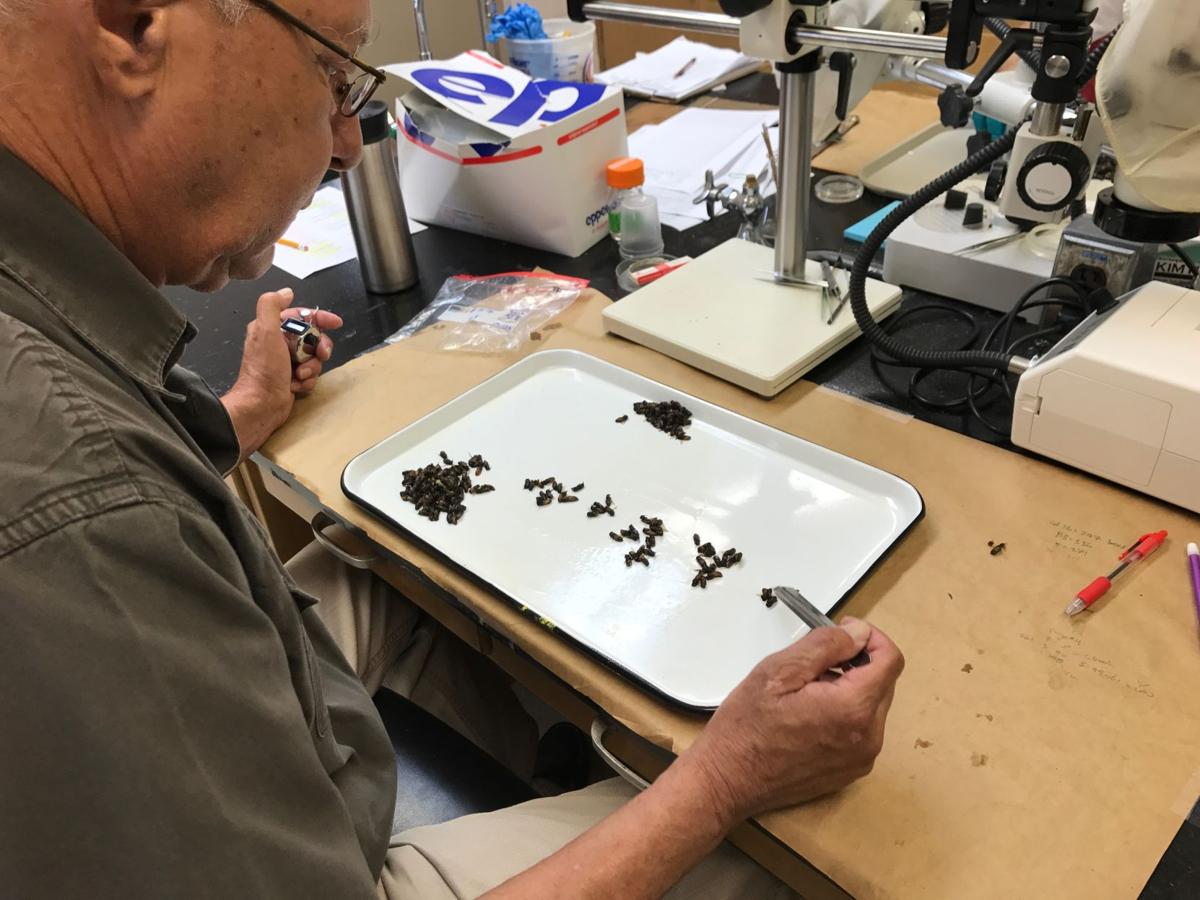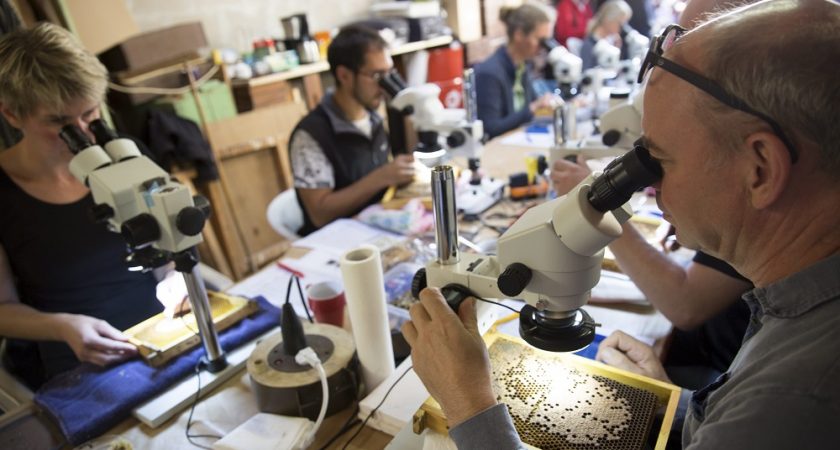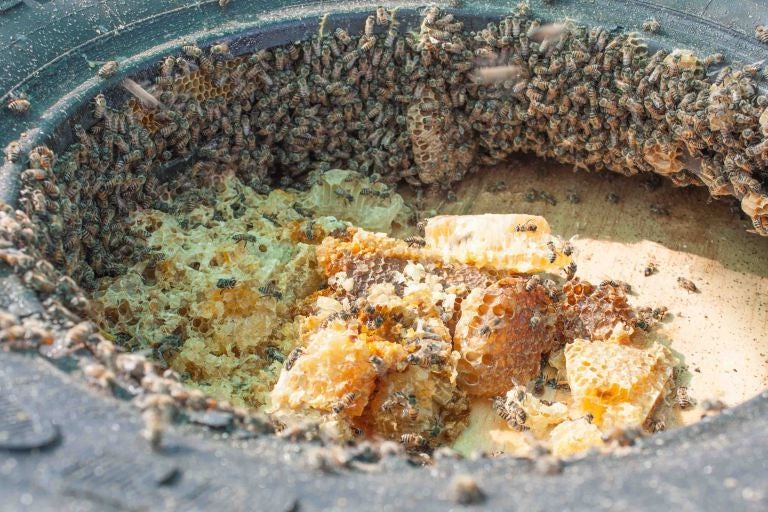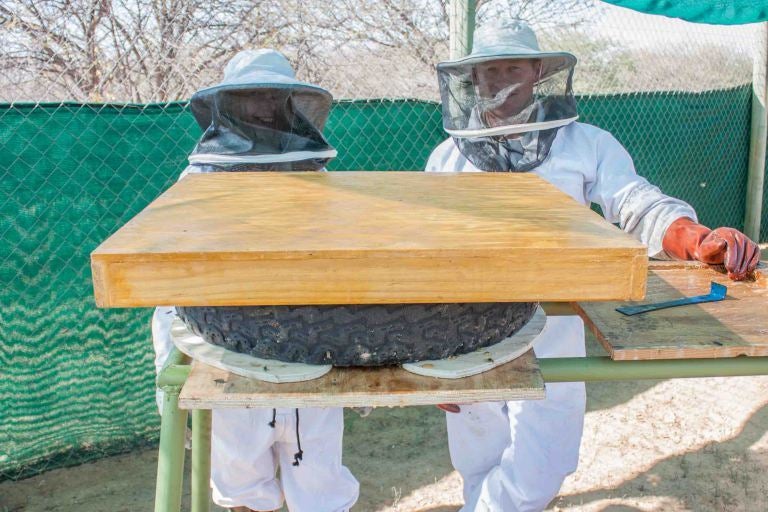Archives – August, 2017
From: Science 2.0
By Howard Minigh
***
Take the class of insecticides so much in the news, neonicotinoids, that some have blamed for problems with bee health. Didn’t the European Union ban them claiming they were posing unacceptable risks to bees? Isn’t that case closed?
August 31, 2017
From: The Frederick News-Post
***
“They’re not in danger of extinction,” said Nathalie Steinhauer, a doctoral candidate at the university — dispelling a common misconception that bees are at risk of disappearing.
***
The No. 1 threat to honeybee colony health is varroa mites, Steinhauer said. The mites arrived in the U.S. in the 1980s and have wreaked havoc on honeybee hives ever since.
Read Complete Article
August 30, 2017
From: LSU Now
LSU AgCenter and the USDA partner for honeybee research
 LSU AgCenter employee examines mites found on bees on Aug. 22. Photo by Hailey Auglair
LSU AgCenter employee examines mites found on bees on Aug. 22. Photo by Hailey Auglair
The LSU AgCenter has partnered with the U.S. Department of Agriculture to study the declining honeybee population.
***
A new grant will allow entomologists, researchers at the USDA Honey Bee Breeding, Genetics and Physiology Research Unit in Baton Rouge and the largest beekeeper in the country to study how stress factors impact honeybees in a two-year study following 400 hives. Their research will include how pesticides, pathogens, and viruses affect bees.
August 29, 2017
From: Cape Cod Times
Many factors involved in honey bee die-offs
A representative of Environment Massachusetts recently wrote that “millions of honey bees are dying off because of neonicotinoids, pesticides that are extremely lethal to bees” (“Celebrating honey bees is celebrating our food,” Letters, Aug. 19).
Truth is, science appears divided on the cause of the past 10 years of mass bee die-off. The U.S. Department of Agriculture’s Research Service has found that some researchers who previously blamed neonicotinoids conducted laboratory experiments by exposing bees to extremely large doses of chemicals that they would never encounter in the field under real-life conditions. Also, as the Huffington Post reported, one such experimenter was on the board of The Organic Center, an arm of the multimillion-dollar Organic Trade Association, a lobby group with strong financial interest in disparaging conventional agriculture, synthetic pesticides and neonics in particular.
August 28, 2017
Editor’s Note: Varroa destuctor, the leading cause of bee health decline, is only one of many invasive pests.
From: United States Department of Agriculture | National Institute of Food and Agriculture
Stop the Invasion: Unwanted Plants, Bugs, and Other Pests
Jennifer Fetter | Renewable Natural Resources Educator, Penn State Extension
Penn State Extension and Pennsylvania 4-H, with funding from the Pennsylvania Department of Agriculture, created Stop the Invasion: Unwanted Plants, Bugs and Other Pests, a hands-on curriculum to address the threat of invasive species.
This project provides a hands-on and interactive curriculum (link is external) to address the threat of invasive pests while making learning fun.
August 25, 2017
From: Growing Produce
Mite Researchers Talk High Infestations in Bee Colonies
Posted By: Carol Miller
 Female varroa destructor on the head of a bee nymph. (Photo by Gilles San Martin.)
Female varroa destructor on the head of a bee nymph. (Photo by Gilles San Martin.)
In 2016, The New York State Beekeeper Tech Team (which is attached to Cornell University’s Dyce Lab Beekeeping Resources) found that 90% of the 19,000 colonies they monitored had varroa mite infestations. See our report on the results here.
American Vegetable Grower reached out to the research team to learn more about the study. Take a look at what Mary Kate Wheeler, Agricultural Economic Analyst at Cornell University, and Paul Cappy, Apiculturist, Division of Plant Industry, New York State Department of Agriculture & Markets, had to say.
August 24, 2017
Editor’s Note: Translated from the French original.
From: Le Quotidien (Luxembourg)
 Around 20 scientists from all over Europe are meeting until Wednesday in Brandenburg. (Photo: Editpress)
Around 20 scientists from all over Europe are meeting until Wednesday in Brandenburg. (Photo: Editpress)
***
This twenty men and women come from all over Europe. Their mission: to participate in the project of genetic improvement of bees, to make them more resistant to their main enemy: varroa. This mite, which parasites larvae, nymphs and adult bees, is native of Asia, where the bees resist … unlike their European cousins! As a result, our beekeepers fear these little vampires who participate in the hecatomb of our friends foragers …
August 23, 2017
From: WXXI News
By Beth Adams
***
Experts are urging local beekeepers to check their hives now and every three weeks for the varroa mite. The tiny parasite is posing a serious threat to New York’s honeybee population, which was reduced 44 percent last year.
“We do surveys twice a year in New York State – we just deal with the little guy, the sideliner beekeeper – and more than half of the beekeepers do not check for this pest,” said Pat Bono, project director of the Rochester-based nonprofit New York Bee Wellness. The USDA funded project educates beginning and small scale, non-commercial beekeepers.
August 22, 2017
From: ScientificBeekeeping.com
Randy Oliver
“If you know the enemy and know yourself, you need not fear the result of a hundred battles”– Sun Tzu. We are all beekeepers; we are also all varroa keepers (some of us better at the latter than the former). Varroa is the enemy of both bees and beekeepers. It would behoove us to know the strengths—and more importantly the weaknesses—of our enemy.
August 21, 2017
Editor’s Note: For more on Africa’s contributions to bee health, see here, here and here.
From: Huffington Post
Dr. Laurie Marker, Contributor Founder and Executive Director of Cheetah Conservation Fund
***
Beekeeping in Africa is very different than beekeeping in the United States, for example. Because of shipping honeybees from around the world to the U.S. for agriculture, U.S. honeybee populations are riddled with pests and diseases. These pests and diseases are shared among honeybee colonies without enough time for resistance to evolve, and populations are plummeting. A small mite called
Varroa destructor, which carries 18 different pathogens in its mouth, is among the worst of the bees’ problems and is guaranteed to be found in every colony in the entire United States. The good news about beekeeping in Southern Africa is that many of these pests and diseases, including the Varroa mite, don’t exist.
 CCF’s feral beehive living in a tire.
CCF’s feral beehive living in a tire. The new and improved feral tire hive.
The new and improved feral tire hive.
Read Complete Article
August 18, 2017
Previous page
 LSU AgCenter employee examines mites found on bees on Aug. 22. Photo by Hailey Auglair
LSU AgCenter employee examines mites found on bees on Aug. 22. Photo by Hailey Auglair Female varroa destructor on the head of a bee nymph. (Photo by Gilles San Martin.)
Female varroa destructor on the head of a bee nymph. (Photo by Gilles San Martin.) Around 20 scientists from all over Europe are meeting until Wednesday in Brandenburg. (Photo: Editpress)
Around 20 scientists from all over Europe are meeting until Wednesday in Brandenburg. (Photo: Editpress) CCF’s feral beehive living in a tire.
CCF’s feral beehive living in a tire. The new and improved feral tire hive.
The new and improved feral tire hive.